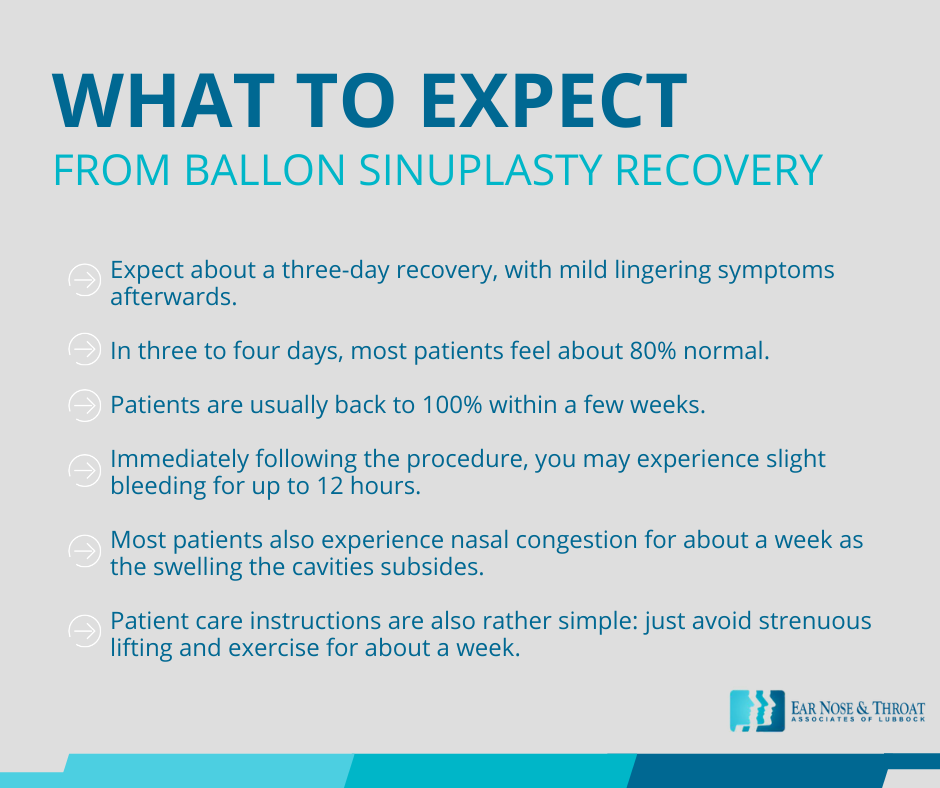What You Need to Know About Balloon Sinuplasty: Risks, Recovery & Side Effects

Sinus issues are the last problem you want to worry about these days.
You have infections that won’t go away (or keep coming back!) and it’s interrupting your life. You’ve tried allergy medications, antibiotics, and pain relievers, but nothing seems to fully clear up your sinuses — and if it does, it’s short-lived.
Could balloon sinuplasty be the answer you’ve hoped for? How involved is balloon sinuplasty and what is the recovery period?
While there is some recovery involved, most patients find balloon sinuplasty to be far less intimidating than they expected. Here’s what you need to know about the procedure and the details of what’s at risk (spoiler alert: not much!)
What is Balloon Sinuplasty?
Balloon sinuplasty is a procedure to open sinus passages. It can be performed in-office, under local anesthesia, and with a recovery period of only 1-2 days!
Everyone has air-filled spaces in the skull called sinuses. We have maxillary sinuses in the cheeks, frontal sinuses in the forehead, ethmoid sinuses between our eyes, and sphenoid sinuses behind the eyes.
Problems happen when these passages become obstructed. When the outflow point is narrow (and therefore easily blocked), you experience pain, pressure, infections, drainage, malaise, low energy, and/or fever. Balloon sinuplasty allows us to open the sinus passageways to prevent these chronic issues and symptoms.
Cardiologists use a similar balloon for angioplasties in the heart. Using a balloon, they dilate carotid arteries to improve blood flow to the heart and avoid the need for open heart surgery. Similarly, we use balloon sinuplasty to improve the patient’s sinus drainage pathway and avoid the need for more extensive surgery.
Am I A Candidate for a Balloon Sinuplasty?
Balloon sinuplasty treats patients with chronic sinus issues. People who experience recurrent sinus infections three or more times per year that seem to persist despite medical management, or people with chronic sinus infections that seem to never fully resolve are potentially strong candidates for this procedure.
Balloon Sinuplasty vs. Sinus Surgery
Balloon sinuplasty is much less invasive than a traditional functional endoscopic sinus surgery (FESS). During FESS, patients undergo general anesthesia where they’re completely asleep in the operating room. Using a variety of instruments, we then cut open and remove significant amounts of tissue and bone within the sinus cavities. Recovery is often extensive and the cost is much higher than office-based procedures because it involves anesthesia and facility charges, in addition to the surgeon.
Balloon sinuplasty uses a non-surgical approach to open these passageways. This procedure takes advantage of the patient’s anatomy by enlarging openings rather than creating artificial openings.
Patients do not need general anesthesia, but instead are given local anesthesia to completely numb the nose. Plus, it’s designed to be done in the office, eliminating the need to use a surgical center.
Balloon Sinuplasty Risks
A balloon sinuplasty comes with extremely low risk. While there are different types of balloons on the market for this procedure, we use the balloon we feel is the safest. With the Acclarent balloon, the guide wire that inserts this balloon is so soft and delicate, it wouldn’t even break an egg yolk. Another potential risk is that the procedure may not be fully effective depending on the significance of your sinus disease and a more extensive sinus surgery could still be necessary.
The “Day of” Timeline
Before the day of the procedure, we prescribe a pain medication and an anxiolytic (anxiety reducing medication) for the patient to take before their appointment. Patients need someone to drive them to the office and home after the procedure.

We start by fully numbing the nose using topical medications, which takes about 30 minutes. After the nose is completely numb, we inject more numbing medication before beginning the sinuplasty. The procedure itself takes 20-30 minutes. During the procedure, the patient may feel slight pressure while the sinuses are dilated but should feel no real discomfort.
After we finish, we suction the nose so it’s completely clean. The patient can leave immediately afterwards. Patients should expect to be in the office for 1- 1.5 hours for the entire process.
What to Expect: Balloon Sinuplasty Recovery
While recovery is very manageable, there’s still a period of healing that must occur following this procedure. Expect about a three-day recovery, with mild lingering symptoms afterwards.
In three to four days, most patients feel about 80% normal. Patients are usually back to 100% within a few weeks. Often, if we do the procedure at the end of the week, you’re back to work by Monday.
Immediately following the procedure, patients experience slight bleeding for up to 12 hours. We’ll provide guides and care instructions for managing it. Most patients also experience nasal congestion for about a week as the swelling the cavities subsides. During this time, patients may also feel mild pain, headaches, and pressure in the sinus cavities. Remember, we actually moved bones around and it takes bones six weeks to heal completely. After three to four weeks, patients are almost back to normal, and by six weeks, they’re fully recovered.
Patient care instructions are also rather simple during balloon sinuplasty recovery: just avoid strenuous lifting and exercise for about a week. While it wouldn’t damage the surgery, it may start a nosebleed if you increase pressure too much. Otherwise, you can follow your normal diet and showering routines.
Balloon Sinuplasty Side Effects
After balloon sinuplasty one should expect some bleeding for several hours immediately following the procedure and minor swelling. Until the swelling subsides, it makes the nose feel tender and a congested.
Overall, balloon sinuplasty risks are low and come with no long-term side effects. If you’re considering this procedure to remedy your sinus issues, give us a call or talk to your ENT about if this is the right procedure for you.
Dr. Cuthbertson is a physician at Ear Nose & Throat Associates of Lubbock. He joined the team at ENT Lubbock from Houston, where he was chief resident of the prestigious Bobby R. Alford Department of Otolaryngology at Baylor College of Medicine. He is board certified in Otolaryngology and Head & Neck Surgery and has quickly built a reputation, not only as an extremely skilled surgeon, but as an approachable and compassionate clinician adept in the newest standards and technologies. Learn more about Dr. Cuthbertson.
Categories:








